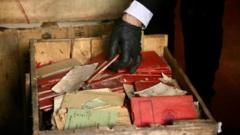In an astonishing revelation, workers clearing the basement of Argentina's Supreme Court stumbled upon wooden crates originally used to transport material from Nazi Germany. These crates contain documents that illuminate connections between Nazi ideologies and the South American nation during World War II. The papers were shipped from the German embassy in Tokyo, arriving clandestinely in June 1941 via a Japanese steamship, the Nan-a-Maru.
During their handling of the crates, workers discovered materials intended to enforce Adolf Hitler's propaganda, revealing a disturbing chapter of Argentine history. The discovery was made as preparations were underway for the court's archives to be relocated to a new museum. Upon investigating the contents, officials found black-and-white photographs and membership booklets adorned with swastikas, which chronicled the Nazi influence in Argentina.
The Argentine Supreme Court initially received the documents after customs officials opened random diplomatic pouches due to their suspicious size. These pouches contained postcards, photographs, and various propaganda items, leading Argentine authorities to confiscate them based on concerns regarding the nation's neutrality during the war.
Initially classified as "personal effects" by the German embassy, all 83 pouches were ultimately seized after a court order in September 1941. Following the war, the country became a refuge for numerous Nazi operatives, raising questions about the extent of their infiltration into Argentine society.
In an official statement, the Supreme Court acknowledged their collaboration with the Buenos Aires Holocaust Museum to create a comprehensive inventory of the intact documents. As historians sift through the archival trove, there is hope that new insights into the financial networks and international ties of Nazi operatives will emerge, adding depth to the understanding of Argentina's complex historical narrative concerning World War II.






















